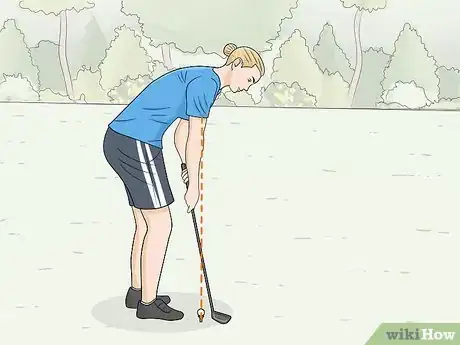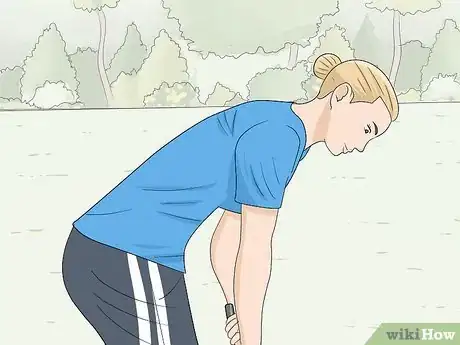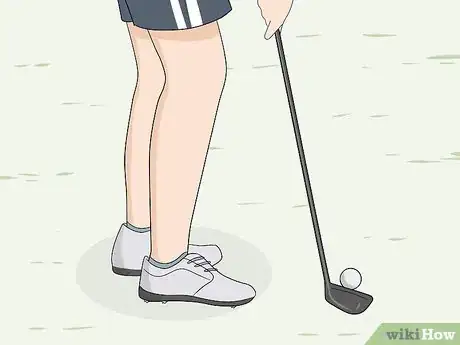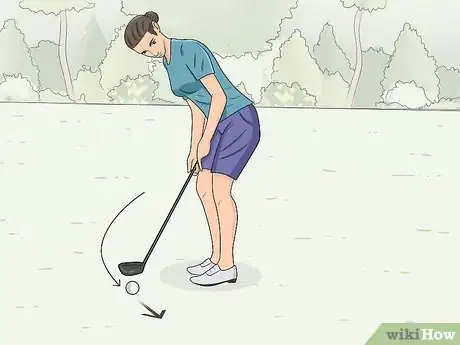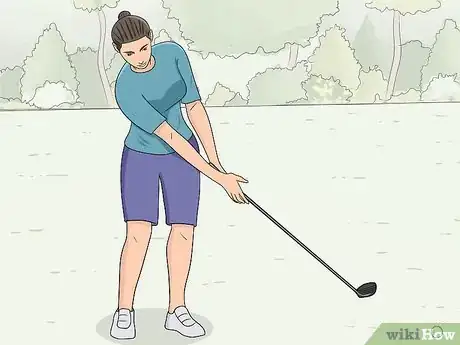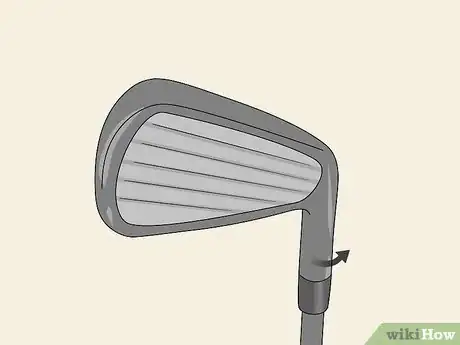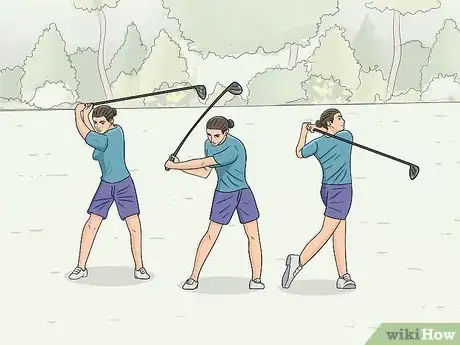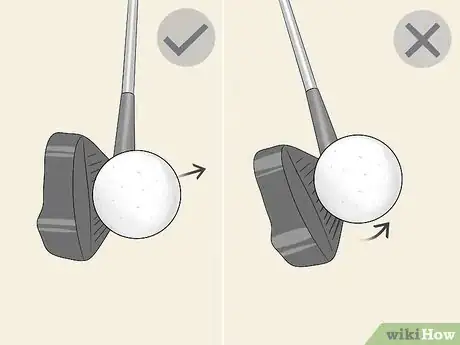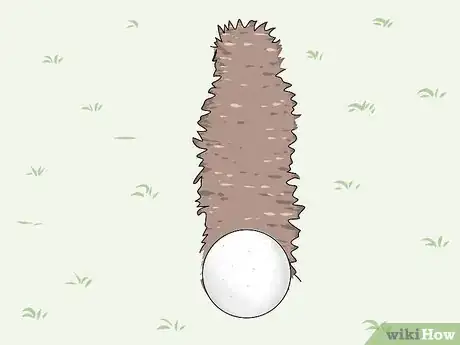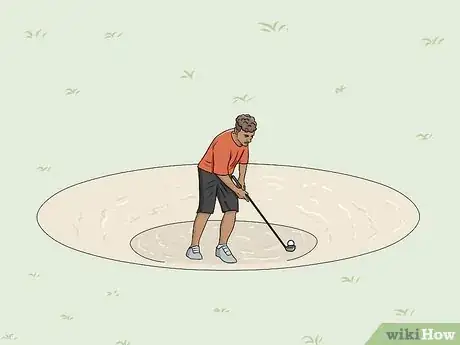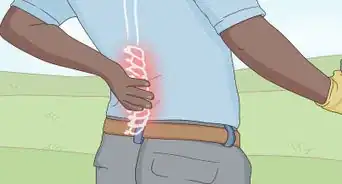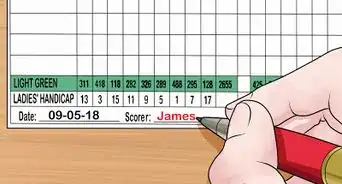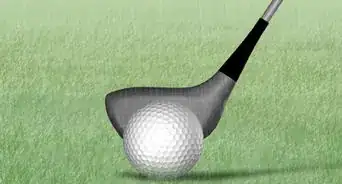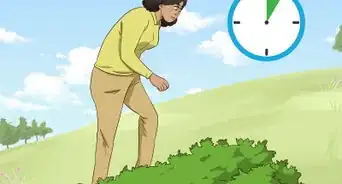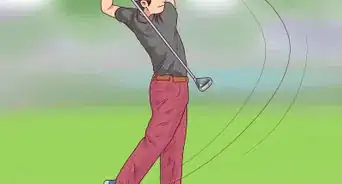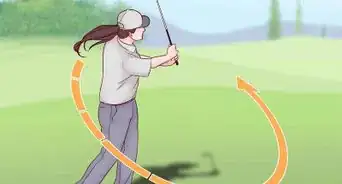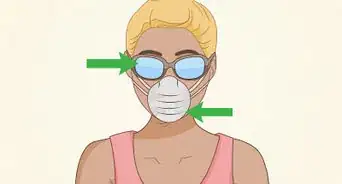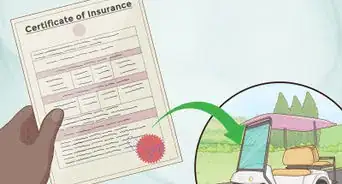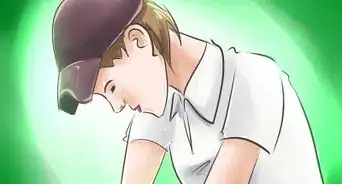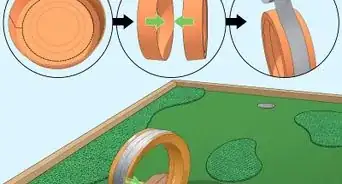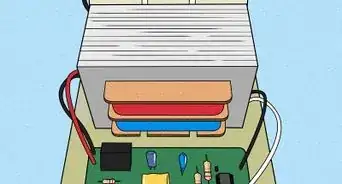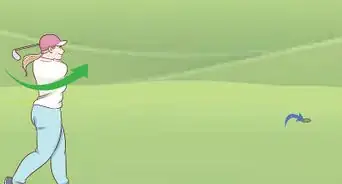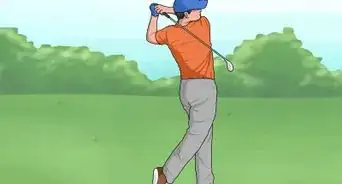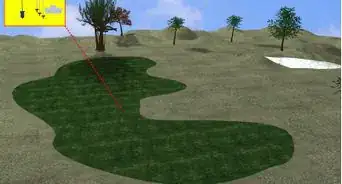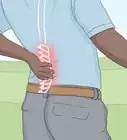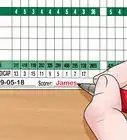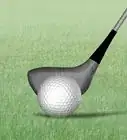This article was co-authored by Michael Metz. Michael Metz is a Golf Instructor and the Director of Instruction at Simi Hills Golf Course. With more than 15 years of experience, Michael is adept at coaching all facets of Golf. Mike uses technology, such as Flightscope, V1 Swing Suite, Blast Motion, and BodiTrak pressure mapping, to provide advanced golf training with quick results.
There are 12 references cited in this article, which can be found at the bottom of the page.
This article has been viewed 64,331 times.
“Irons” are a type of club employed in the game of golf. Whereas “woods” are used to drive the ball long distances, irons typically have shorter shafts, smaller heads, and more angled faces, which make them better suited for making short-to-mid-range shots in a variety of green conditions. The key to becoming a top shot with your irons is to dial in your stance and ball placement to ensure that you’re getting the right point of contact on the ball. After that, it’s simply a matter of making smooth, controlled swings that push the ball forward, letting the club’s lofted head generate the lift needed to send it sailing.
Steps
Setting up Your Shot
-
1Position the ball slightly forward of center in your stance. Stand with the ball a little closer to your lead foot. As a good general starting point, many experts recommend lining up the ball with the logo on the breast pocket of your shirt. If you’re not wearing a shirt with a logo, this will be a couple of inches to the left of the center of your chest (or to the right if you're a left-handed golfer).[1]
- Avoid placing the ball any further forward than your front armpit or any further back than the center of your body.[2]
- Starting with the ball a little more forward will prevent you from having to chop down at it, which usually just results in short, sloppy fading shots.
-
2Lean in slightly to stay close to the ball. Bend at the waist until your back forms roughly a 50-degree angle, keeping your spine as straight as possible. Hold your head up so that your crown is in line with your back and hips. [3] Try to maintain this angle until the ball leaves the head of the club.[4]
- It can help to imagine your chest "hovering" over the ball up until the moment of impact.[5]
- Irons tend to be shorter than woods. For this reason, it’s important to keep your chest and shoulders low throughout your swing, even more so than when blasting a drive.
Tip: When viewed from the side, the angles created by your upper and lower body should look like the hands of a clock in the “1:30” position.
Advertisement -
3Give yourself a comfortable amount of space for your swing. A good rule of thumb is to leave about a hand’s width between the backs of your arms and your body. If you’re too close to the ball, you’ll be forced to swing just in front of your feet, which can make you feel cramped. If you’re too far away, the added distance may give your swing more of a horizontal angle, like a baseball swing.[6]
- Get in the habit of double-checking your body space as part of your setup. You want to keep a consistent amount of space on every shot, regardless of the iron you’re playing with.
Perfecting Your Swing
-
1Use low, smooth swings to make sure you're hitting the ball forward. As you begin your backswing, keep it “low and slow,” easing the head of the club back, then reversing direction and letting it swoop down to meet the ball in a shallow arc. By the time the head of the club comes within a few inches of the ball, it should be moving more or less straight ahead.[7]
- Remember to keep your wrists locked until you enter the apex of your swing, just like with any other shot.[8]
- A more subtle swing trajectory will also guarantee that you’re sending the ball forward as opposed to upwards.
Tip: A proper swing will feel fluid and controlled, with more of a sweeping motion than hacking one. There’s no need to attack the ball with the same kind of intensity you would use for a drive.
-
2Tilt your body away from the ball as you make contact. Shift your weight the same way you would for a normal swing, only keep your head and shoulders behind the ball at the moment of impact.[9] This will allow you to channel your full momentum into the ball and ensure that the face of the club touches down at just the right angle in relation to the ball’s edge.[10]
- Try to let your body take on a loose curve, from the top of your head to the foot of your back leg.
- If you’re a right-handed golfer, make sure your left shoulder stays slightly higher than your right. If you’re left-handed, keep your right shoulder higher.[11]
-
3“Shape” your iron to better control the direction of your shot. Rotate the head of the club a few degrees to the left or right to influence the path of the ball as needed. When done correctly, shaping can enhance your overall accuracy and control, especially on hilly courses or in windy conditions.[12]
- If you're facing a slight bank on your lefthand side, shaping your club to the left a small amount can help you compensate for the roll caused by the incline and place the ball closer to the hole.
- Shaping is an advanced technique and requires a lot of practice to get right. It may take dozens or even hundreds of swings before you get to the point where you can deliver the ball exactly where you want it to go.[13]
-
4Maintain your posture throughout your entire swing. Once you’ve got your head, back, shoulders, arms, hips, and feet right where you want them, make sure they stay there until the ball is clear of your club.[14] If any part of your form breaks down between your backswing and your follow-through, it could increase the risk of a mishit.[15]
- Resist the urge the stand up or raise your chest and shoulders prematurely. This won’t help you get more lift—in fact, it does the exact opposite, as it causes the head of your club to strike higher up on the ball.[16]
- Train yourself to freeze for 1-2 full seconds after your follow-through to avoid developing the bad habit of coming out of position early.
Using Your Irons Effectively
-
1Let the club lift the ball rather than trying to force it into the air. One common mistake that newer players often make is attempting to “scoop” the ball, or fling it upwards in an effort to get it airborne. By doing this, you only end up sacrificing accuracy and distance. The lofted head of the club is what’s responsible for creating lift, so just focus on connecting squarely and pushing the ball forward. The iron will take care of the rest.[17]
- To get the hang of hitting in a forward direction, take a few half-speed swings using a putter, then switch to your iron of choice and replicate the same motion.
-
2Check your divots after each shot. A good iron shot will often end with a divot, which happens when the head of the club slices into the ground after striking the ball, taking a piece of the turf with it. These marks can be useful indicators of strong, precise swings. With enough practice, you’ll notice divots popping up after almost every shot.[18]
- There’s a big difference between ending a shot with a nice, clean divot and simply digging up chunks of the green. You’ll know it when you feel it.
- With a textbook divot, the head of your club should contact the ball first, then the ground. This means that the divot itself will be in front of the ball, not behind it.[19]
Warning: If the turf looks like a gopher has been passed through after a few swings, it’s probably because you’re chopping down at the ball or trying to scoop it into the air instead of trusting the iron carry it.
-
3Play your irons to get yourself out of sticky situations. Irons are designed to get down under the ball and lift them clear of the ground. This feature makes them perfect for saving wayward balls from wilder parts of the course, including the rough, low brush, bunkers, and even shallow water hazards. Just be sure to select an iron with a loft suitable for the severity of the terrain.[20]
- The number stamped on an iron corresponds to the amount of loft produced by the head. The higher the number, the steeper the angle and the greater the loft.[21]
- If you find yourself stuck in a deep bunker, you also have the option of grabbing a wedge. Wedges are a special subset of irons with short shafts, high lofts, and heavy heads. They’re used mostly for making short-distance “lob” shots.
Expert Q&A
-
QuestionWhy am I so inconsistent with my irons?
 Michael MetzMichael Metz is a Golf Instructor and the Director of Instruction at Simi Hills Golf Course. With more than 15 years of experience, Michael is adept at coaching all facets of Golf. Mike uses technology, such as Flightscope, V1 Swing Suite, Blast Motion, and BodiTrak pressure mapping, to provide advanced golf training with quick results.
Michael MetzMichael Metz is a Golf Instructor and the Director of Instruction at Simi Hills Golf Course. With more than 15 years of experience, Michael is adept at coaching all facets of Golf. Mike uses technology, such as Flightscope, V1 Swing Suite, Blast Motion, and BodiTrak pressure mapping, to provide advanced golf training with quick results.
Golf Instructor It probably has something to do with balance. People are so into hitting it far that they are never able to end up in a consistent position post impact. I don't care how fast my clients swing, as long as they're balanced and stable when they finish their swing.
It probably has something to do with balance. People are so into hitting it far that they are never able to end up in a consistent position post impact. I don't care how fast my clients swing, as long as they're balanced and stable when they finish their swing. -
QuestionHow do I get more height with all my clubs?
 Community AnswerOpen your club face slightly more. Make sure you're getting underneath the ball when striking so you don't top it. During your practice swing, make sure you are slightly brushing the grass with your club; this means you will definitely get under it, not top it.
Community AnswerOpen your club face slightly more. Make sure you're getting underneath the ball when striking so you don't top it. During your practice swing, make sure you are slightly brushing the grass with your club; this means you will definitely get under it, not top it.
Warnings
- Overall, irons are probably the hardest type of club to master. Keep in mind that it will likely take many long hours of practice before you begin to see consistent improvement in the distance and accuracy of your shots.⧼thumbs_response⧽
References
- ↑ https://www.golfdigest.com/story/hit-crisp-irons-like-a-pro
- ↑ https://www.golftipsmag.com/instruction/iron-play/five-fundamentals-of-iron-play/
- ↑ Michael Metz. Golf Instructor. Expert Interview. 24 February 2022.
- ↑ https://www.golftipsmag.com/instruction/iron-play/five-fundamentals-of-iron-play/
- ↑ https://www.golfdigest.com/story/hit-crisp-irons-like-a-pro
- ↑ https://golftips.golfweek.com/practice-golf-driving-range-20168.html
- ↑ https://www.golfdigest.com/gallery/iron-tips-photos#1
- ↑ https://www.golftipsmag.com/instruction/iron-play/five-fundamentals-of-iron-play/
- ↑ Michael Metz. Golf Instructor. Expert Interview. 24 February 2022.
- ↑ https://www.youtube.com/watch?v=xKqbi2VsszM&feature=youtu.be&t=234
- ↑ https://www.golfdigest.com/gallery/iron-tips-photos#3
- ↑ https://golftips.golfweek.com/practice-golf-driving-range-20168.html
- ↑ https://www.golfdistillery.com/tweaks/swing/club-path/
- ↑ Michael Metz. Golf Instructor. Expert Interview. 24 February 2022.
- ↑ https://www.golfdigest.com/story/hit-crisp-irons-like-a-pro
- ↑ https://www.golfdigest.com/story/hit-crisp-irons-like-a-pro
- ↑ https://www.youtube.com/watch?v=xKqbi2VsszM&feature=youtu.be&t=42
- ↑ https://golftips.golfweek.com/practice-golf-driving-range-20168.html
- ↑ https://www.youtube.com/watch?v=WSZNcbbNCZo&feature=youtu.be&t=57
- ↑ https://golftips.golfweek.com/golf-club-use-when-1417.html
- ↑ https://golftips.golfweek.com/numbers-golf-clubs-mean-20158.html
